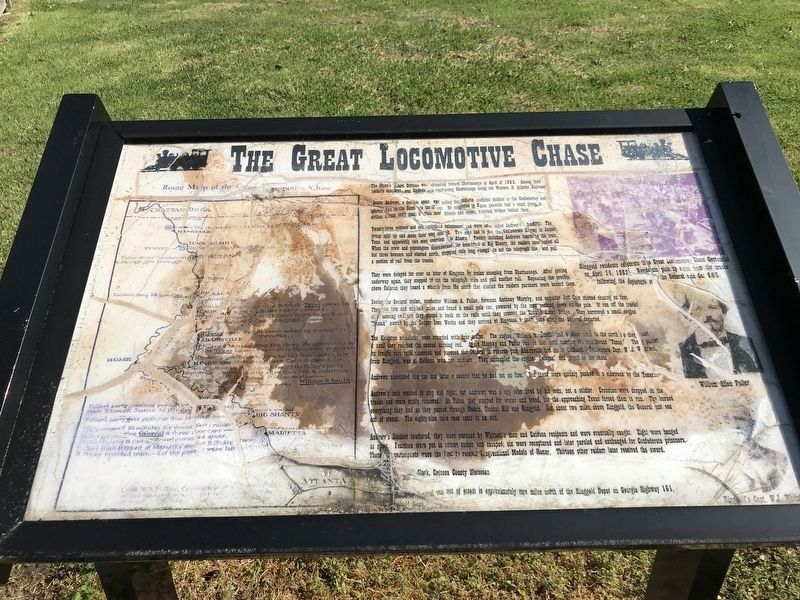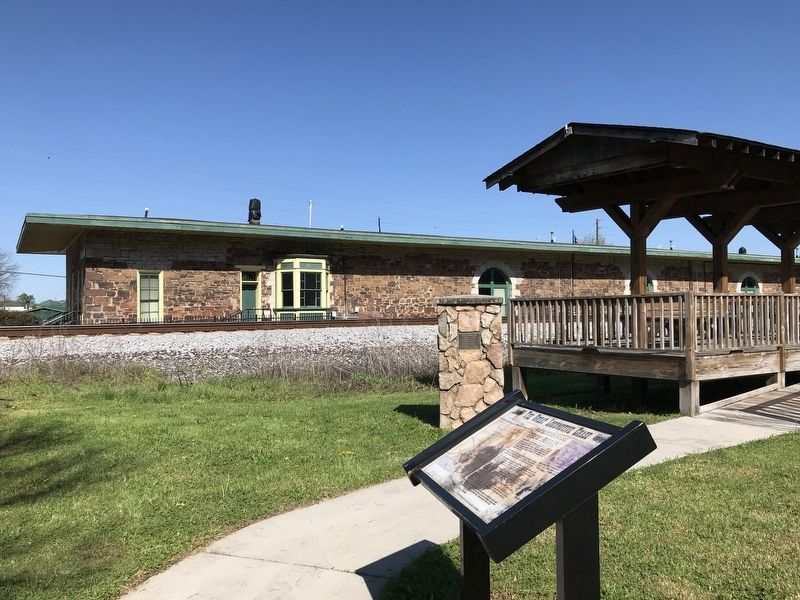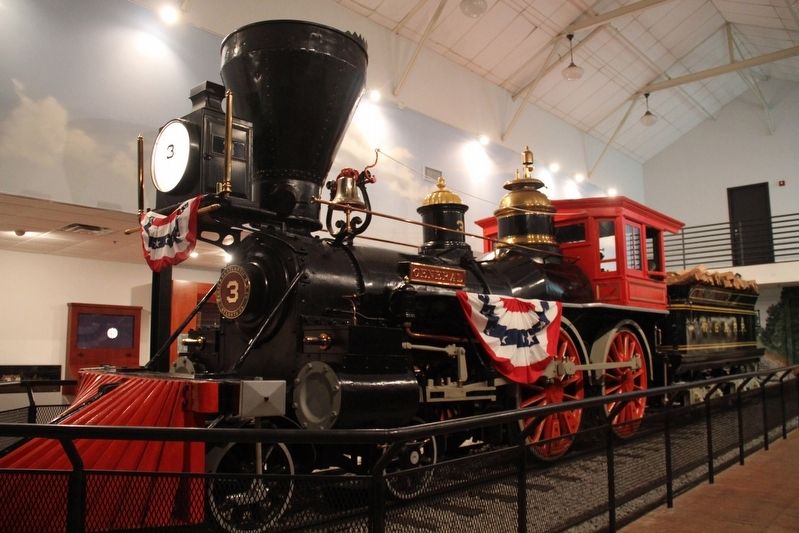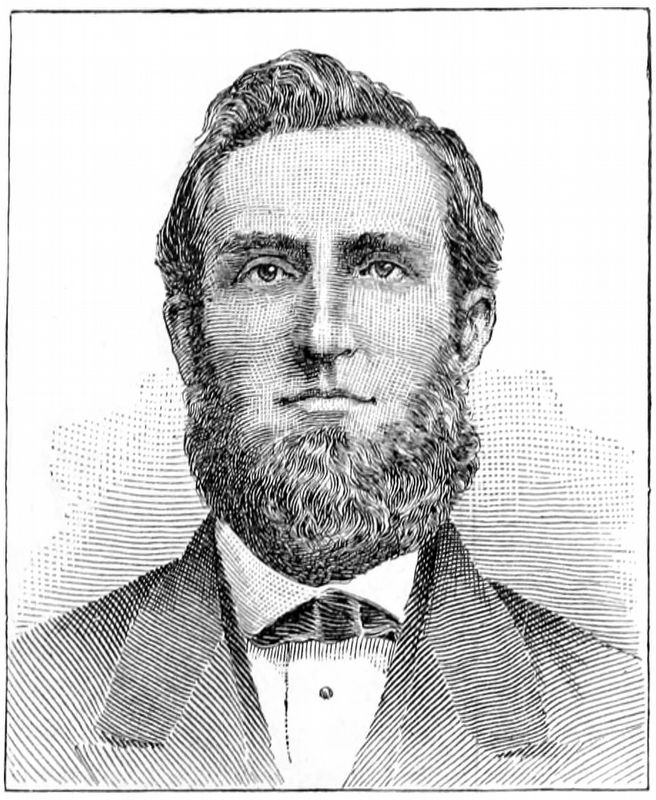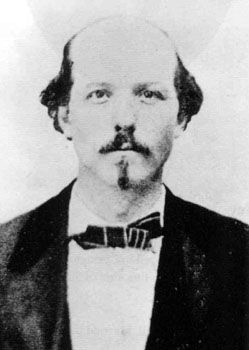Ringgold in Catoosa County, Georgia — The American South (South Atlantic)
The Great Locomotive Chase
James Andrews, a double agent, was selling the malaria medicine quinine to the Confederacy and information on the South to the Union. He suggested to Union generals that a small group in civilian dress could steal a train near Atlanta and return, burning bridges behind them.
Twenty-three soldiers and one civilian volunteered and were later called Andrews' Raiders. The group split up and made their way south. Two men had to join the Confederate Army in Jasper, Tenn. and apparently two men overslept in Atlanta. Twenty including Andrews boarded the train. When the crew and passengers disembarked for breakfast at Big Shanty, the raiders uncoupled all but three boxcars and started north, stopping only long enough to cut the telegraph line and pull a section of rail from the tracks.
They were delayed for over an hour at Kingston by trains escaping from Chattanooga. After getting underway again, they stopped to cut the telegraph wire and pull another rail. Repeating the process above Calhoun they heard a whistle from the south that alerted the raiders pursuers were behind them.
Seeing the General stolen, conductor William A. Fuller, foreman Anthony Murphy, and engineer Jeff Cain started chasing on foot. They ran two and one-half miles and found a small pole car, powered by the men pushing down on the pole. It ran off the tracks at a missing rail and they placed it back on the rails until they crossed the Etowah River Bridge. They borrowed a small engine “Yonah” owned by the Cooper Iron Works and they arrived at Kingston a short lime after the General departed.
The Kingston sidetracks were crowded with four trains. The engine “William B. Smith” had a clear track to the north so they used it until they reached the second missing rail. Again Murphy and Fuller ran on foot until meeting the southbound “Texas.” They pushed its freight cars to a sidetrack and pursued the General in reverse past Adairsville and on to Calhoun. Confederate Capt. W.J. Whitsett, from Ringgold, was at Calhoun with ten soldiers. They uncoupled the engine “Catoosa” and joined in the chase.
Andrews uncoupled one car and later a second that he had set on fire. But these were quickly pushed to a sidetrack by the Texas.
Andrews' men wanted to stop and fight, but Andrews was a spy who lived by his wits, not a soldier. Crossties were dropped on the tracks and were easily removed. At Tilton they stopped for water and wood, but the approaching Texas forced them
to run. They burned
everything they had as they passed through Dalton, Tunnel Hill and Ringgold. But about two miles above Ringgold, the General just ran out of steam. The eighty-nine mile race came to an end.
Andrews' Raiders scattered, they were pursued by Whitsett's men and Catoosa residents and were eventually caught. Eight were hanged as spies. Fourteen were put in prison camps and escaped; six were recaptured and later paroled and exchanged for Confederate prisoners. These six participants were the first to receive Congressional Medals of Honor. Thirteen other raiders later received the award.
— W. “Bill” Clark, Catoosa County Historian
Where the General ran out of steam is approximately two miles north of the Ringgold Depot on Georgia Highway 151.
Route Map of the Great Locomotive Chase (south to north):
1. Capt. W.A. Fuller, conductor of a northbound, mixed passenger & freight train, left Atlanta at 4 a.m., Saturday, April 12, 1862.
2. Fuller's train stopped at Marietta about 5:15. Andrews & 19 men boarded train — 2 of the party were left behind.
3. Train stopped 20 minutes for breakfast; raiders seized locomotive General & three boxcars. Fuller, Murphy & Cain (engineer) pursued afoot.
4. Fuller's party gets push-car from section-hands.
5. Fuller's party continues pursuit on Yonah from Etowah Station to Kingston (11 miles).
6. Kingston — Raiders delayed by S. bound freights; Fuller's party arrives shortly after they left & continue with the Rome R.R. locomotive William B. Smith.
7. Broken track - Rome engine halted - pursuers again afoot - engineer Cain dropped out.
8. Fuller & Murphy stop the down freight - pulled by the Texas locomotive - Peter Bracken, engineer.
9. Texas drops freight cars - takes up pursuit in reverse.
10. Fuller in close pursuit slows down to pick up Ed. Henderson - Dalton telegraph operator.
11. Raiders stop to cut wire & track - Texas comes in sight - raiders hurry onward
12. Raiders drop 1st box car.
13. Raiders drop 2nd box car.
14. Fuller drops Henderson - message gets through.
15. Raiders dash through tunnel - so do the pursuers.
16. The chase ends - 2 miles N. of Ringgold.
Captions
Top: Ringgold residents celebrate the Great Locomotive Chase Centennial on April 14, 1962. Residents pick up coins from the tracks following the departure of the General and Car 665.
Center: William Allen Fuller
Bottom: Ringgold's Capt. W.J. Whitsett.
Topics. This historical marker is listed in these topic lists: Railroads & Streetcars
• War, US Civil. A significant historical date for this entry is April 12, 1862.
Location. 34° 54.903′ N, 85° 6.432′ W. Marker is in Ringgold, Georgia, in Catoosa County. Marker is on Georgia Route 151 Spur near U.S. 41/76, on the left when traveling north. Marker is across the tracks from the Ringgold Depot. Touch for map. Marker is in this post office area: Ringgold GA 30736, United States of America. Touch for directions.
Other nearby markers. At least 8 other markers are within walking distance of this marker. The Ringgold Depot (within shouting distance of this marker); Barger Bridge (within shouting distance of this marker); Western & Atlantic Depot (within shouting distance of this marker); Battle of Chickamauga (about 700 feet away, measured in a direct line); Actions At Ringgold (approx. 0.2 miles away); Catoosa County War Memorial (approx. 0.2 miles away); Confederate Hospitals (approx. 0.2 miles away); Catoosa County (approx. 0.2 miles away). Touch for a list and map of all markers in Ringgold.
Regarding The Great Locomotive Chase. Andrews was the only raider not awarded a Congressional Medal of Honor because, as a civilian, he was ineligible to receive it.
Credits. This page was last revised on April 12, 2021. It was originally submitted on April 12, 2021, by Duane and Tracy Marsteller of Murfreesboro, Tennessee. This page has been viewed 773 times since then and 151 times this year. Photos: 1, 2, 3, 4, 5. submitted on April 12, 2021, by Duane and Tracy Marsteller of Murfreesboro, Tennessee.
